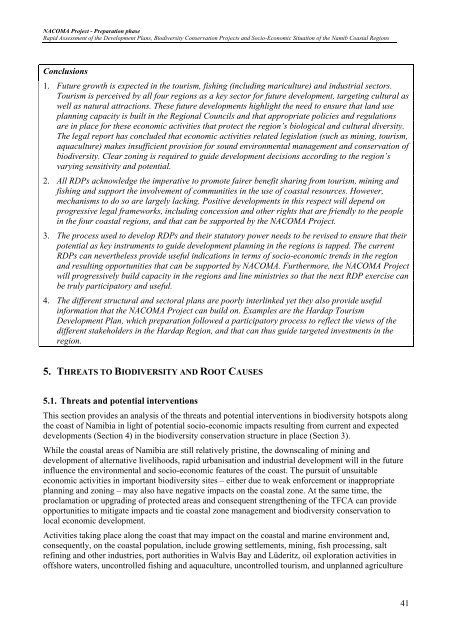Full report LR.pdf - DLIST Benguela
Full report LR.pdf - DLIST Benguela
Full report LR.pdf - DLIST Benguela
- No tags were found...
Create successful ePaper yourself
Turn your PDF publications into a flip-book with our unique Google optimized e-Paper software.
NACOMA Project - Preparation phaseRapid Assessment of the Development Plans, Biodiversity Conservation Projects and Socio-Economic Situation of the Namib Coastal RegionsConclusions1. Future growth is expected in the tourism, fishing (including mariculture) and industrial sectors.Tourism is perceived by all four regions as a key sector for future development, targeting cultural aswell as natural attractions. These future developments highlight the need to ensure that land useplanning capacity is built in the Regional Councils and that appropriate policies and regulationsare in place for these economic activities that protect the region’s biological and cultural diversity.The legal <strong>report</strong> has concluded that economic activities related legislation (such as mining, tourism,aquaculture) makes insufficient provision for sound environmental management and conservation ofbiodiversity. Clear zoning is required to guide development decisions according to the region’svarying sensitivity and potential.2. All RDPs acknowledge the imperative to promote fairer benefit sharing from tourism, mining andfishing and support the involvement of communities in the use of coastal resources. However,mechanisms to do so are largely lacking. Positive developments in this respect will depend onprogressive legal frameworks, including concession and other rights that are friendly to the peoplein the four coastal regions, and that can be supported by the NACOMA Project.3. The process used to develop RDPs and their statutory power needs to be revised to ensure that theirpotential as key instruments to guide development planning in the regions is tapped. The currentRDPs can nevertheless provide useful indications in terms of socio-economic trends in the regionand resulting opportunities that can be supported by NACOMA. Furthermore, the NACOMA Projectwill progressively build capacity in the regions and line ministries so that the next RDP exercise canbe truly participatory and useful.4. The different structural and sectoral plans are poorly interlinked yet they also provide usefulinformation that the NACOMA Project can build on. Examples are the Hardap TourismDevelopment Plan, which preparation followed a participatory process to reflect the views of thedifferent stakeholders in the Hardap Region, and that can thus guide targeted investments in theregion.5. THREATS TO BIODIVERSITY AND ROOT CAUSES5.1. Threats and potential interventionsThis section provides an analysis of the threats and potential interventions in biodiversity hotspots alongthe coast of Namibia in light of potential socio-economic impacts resulting from current and expecteddevelopments (Section 4) in the biodiversity conservation structure in place (Section 3).While the coastal areas of Namibia are still relatively pristine, the downscaling of mining anddevelopment of alternative livelihoods, rapid urbanisation and industrial development will in the futureinfluence the environmental and socio-economic features of the coast. The pursuit of unsuitableeconomic activities in important biodiversity sites – either due to weak enforcement or inappropriateplanning and zoning – may also have negative impacts on the coastal zone. At the same time, theproclamation or upgrading of protected areas and consequent strengthening of the TFCA can provideopportunities to mitigate impacts and tie coastal zone management and biodiversity conservation tolocal economic development.Activities taking place along the coast that may impact on the coastal and marine environment and,consequently, on the coastal population, include growing settlements, mining, fish processing, saltrefining and other industries, port authorities in Walvis Bay and Lüderitz, oil exploration activities inoffshore waters, uncontrolled fishing and aquaculture, uncontrolled tourism, and unplanned agriculture41












